University Leadership Challenges Report for MANAGEMENT 6 Course
VerifiedAdded on 2022/09/25
|9
|2080
|22
Report
AI Summary
This report analyzes three key leadership challenges based on the MANAGEMENT 6 course. The first section explores the traits and behaviors of entrepreneurial leaders, discussing challenges such as criticism and self-doubt, and non-effective decisions during recruitment. The second section delves into the emotional and intellectual capabilities of leaders, including self-awareness, self-management, and social awareness, and emphasizes the importance of whole leadership. The final section focuses on retaining good employees and improving employee engagement by addressing the leader-follower relationship and implementing effective communication strategies. The report uses real-world examples and references academic sources to support its arguments, demonstrating a critical understanding of leadership principles.
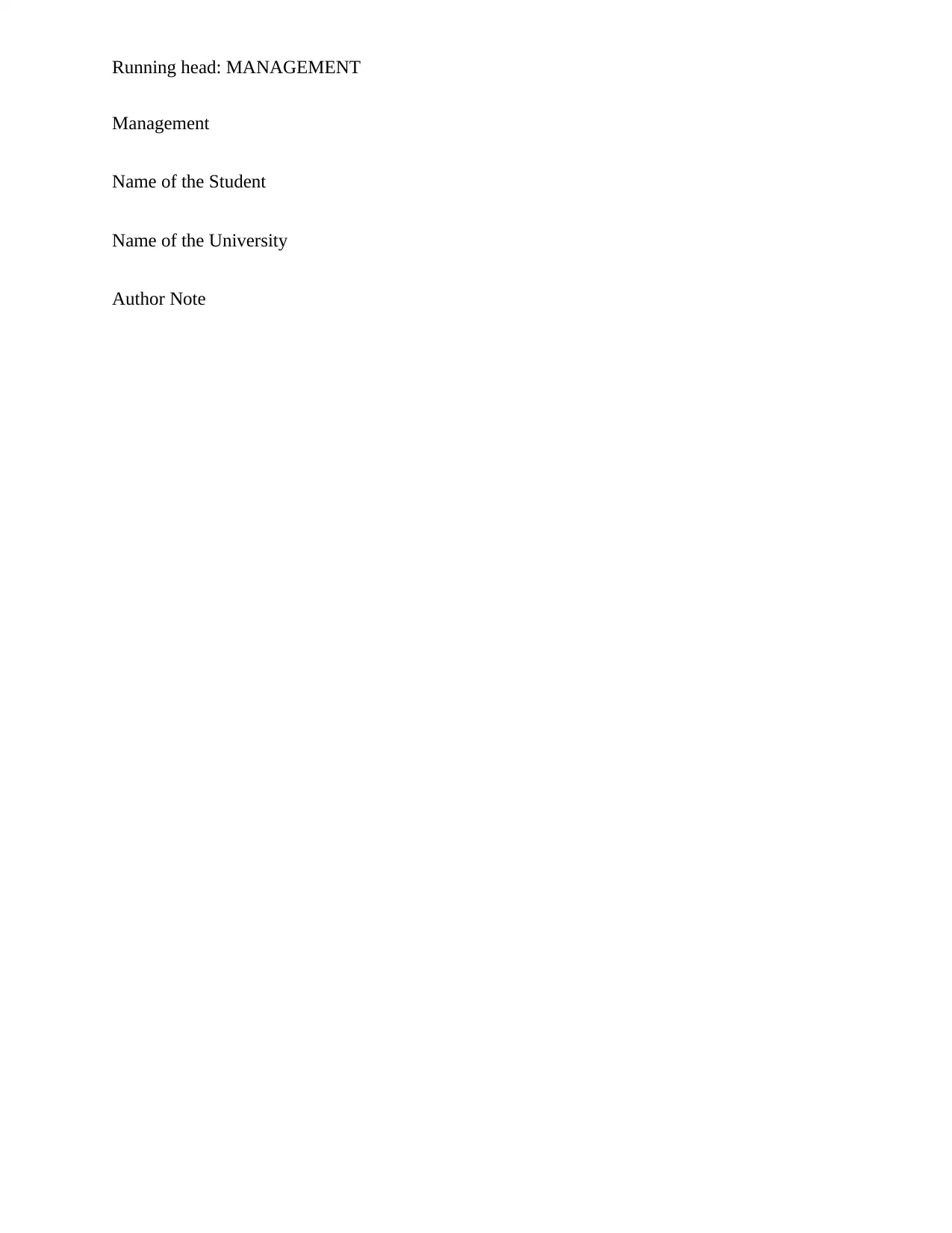
Running head: MANAGEMENT
Management
Name of the Student
Name of the University
Author Note
Management
Name of the Student
Name of the University
Author Note
Paraphrase This Document
Need a fresh take? Get an instant paraphrase of this document with our AI Paraphraser
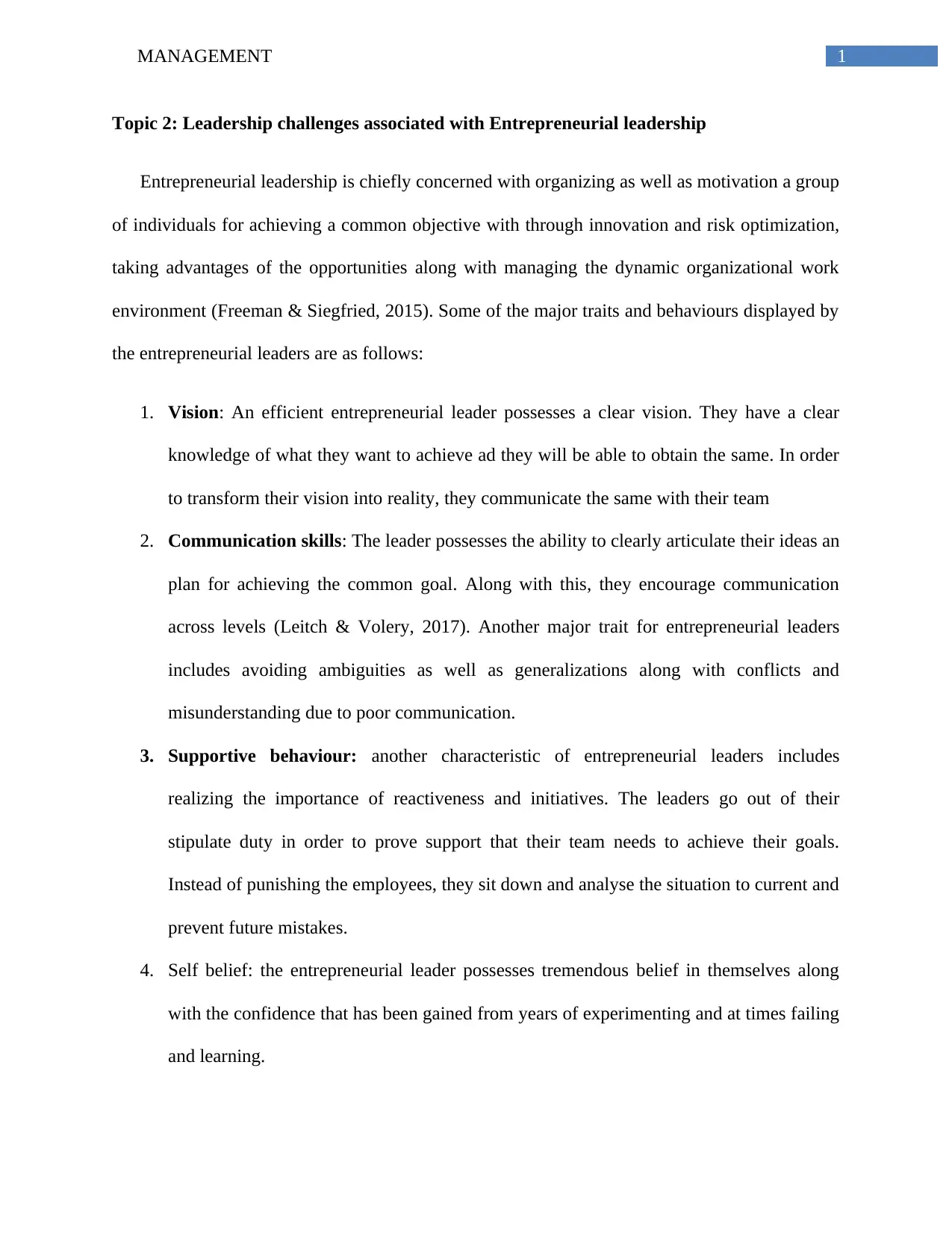
1MANAGEMENT
Topic 2: Leadership challenges associated with Entrepreneurial leadership
Entrepreneurial leadership is chiefly concerned with organizing as well as motivation a group
of individuals for achieving a common objective with through innovation and risk optimization,
taking advantages of the opportunities along with managing the dynamic organizational work
environment (Freeman & Siegfried, 2015). Some of the major traits and behaviours displayed by
the entrepreneurial leaders are as follows:
1. Vision: An efficient entrepreneurial leader possesses a clear vision. They have a clear
knowledge of what they want to achieve ad they will be able to obtain the same. In order
to transform their vision into reality, they communicate the same with their team
2. Communication skills: The leader possesses the ability to clearly articulate their ideas an
plan for achieving the common goal. Along with this, they encourage communication
across levels (Leitch & Volery, 2017). Another major trait for entrepreneurial leaders
includes avoiding ambiguities as well as generalizations along with conflicts and
misunderstanding due to poor communication.
3. Supportive behaviour: another characteristic of entrepreneurial leaders includes
realizing the importance of reactiveness and initiatives. The leaders go out of their
stipulate duty in order to prove support that their team needs to achieve their goals.
Instead of punishing the employees, they sit down and analyse the situation to current and
prevent future mistakes.
4. Self belief: the entrepreneurial leader possesses tremendous belief in themselves along
with the confidence that has been gained from years of experimenting and at times failing
and learning.
Topic 2: Leadership challenges associated with Entrepreneurial leadership
Entrepreneurial leadership is chiefly concerned with organizing as well as motivation a group
of individuals for achieving a common objective with through innovation and risk optimization,
taking advantages of the opportunities along with managing the dynamic organizational work
environment (Freeman & Siegfried, 2015). Some of the major traits and behaviours displayed by
the entrepreneurial leaders are as follows:
1. Vision: An efficient entrepreneurial leader possesses a clear vision. They have a clear
knowledge of what they want to achieve ad they will be able to obtain the same. In order
to transform their vision into reality, they communicate the same with their team
2. Communication skills: The leader possesses the ability to clearly articulate their ideas an
plan for achieving the common goal. Along with this, they encourage communication
across levels (Leitch & Volery, 2017). Another major trait for entrepreneurial leaders
includes avoiding ambiguities as well as generalizations along with conflicts and
misunderstanding due to poor communication.
3. Supportive behaviour: another characteristic of entrepreneurial leaders includes
realizing the importance of reactiveness and initiatives. The leaders go out of their
stipulate duty in order to prove support that their team needs to achieve their goals.
Instead of punishing the employees, they sit down and analyse the situation to current and
prevent future mistakes.
4. Self belief: the entrepreneurial leader possesses tremendous belief in themselves along
with the confidence that has been gained from years of experimenting and at times failing
and learning.
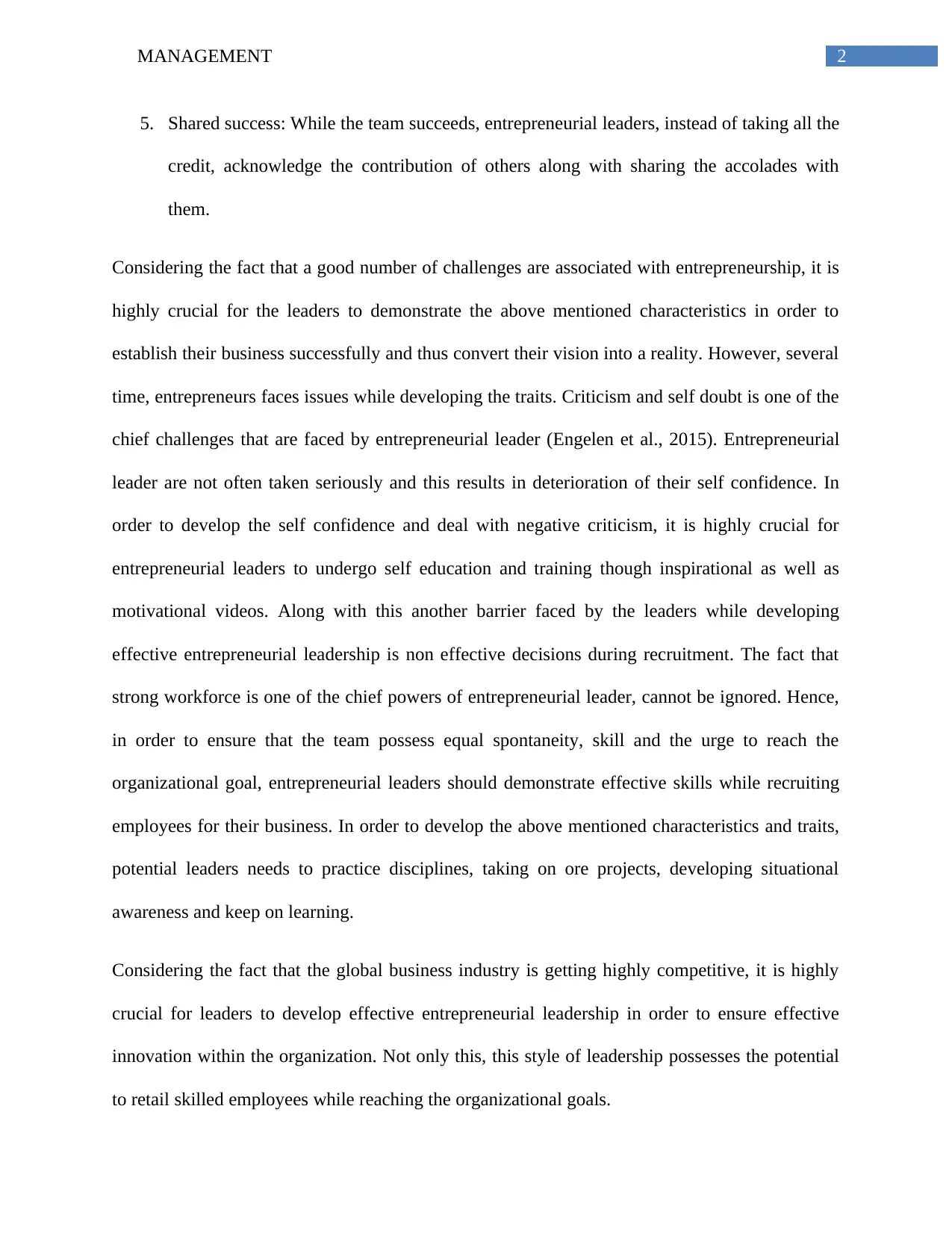
2MANAGEMENT
5. Shared success: While the team succeeds, entrepreneurial leaders, instead of taking all the
credit, acknowledge the contribution of others along with sharing the accolades with
them.
Considering the fact that a good number of challenges are associated with entrepreneurship, it is
highly crucial for the leaders to demonstrate the above mentioned characteristics in order to
establish their business successfully and thus convert their vision into a reality. However, several
time, entrepreneurs faces issues while developing the traits. Criticism and self doubt is one of the
chief challenges that are faced by entrepreneurial leader (Engelen et al., 2015). Entrepreneurial
leader are not often taken seriously and this results in deterioration of their self confidence. In
order to develop the self confidence and deal with negative criticism, it is highly crucial for
entrepreneurial leaders to undergo self education and training though inspirational as well as
motivational videos. Along with this another barrier faced by the leaders while developing
effective entrepreneurial leadership is non effective decisions during recruitment. The fact that
strong workforce is one of the chief powers of entrepreneurial leader, cannot be ignored. Hence,
in order to ensure that the team possess equal spontaneity, skill and the urge to reach the
organizational goal, entrepreneurial leaders should demonstrate effective skills while recruiting
employees for their business. In order to develop the above mentioned characteristics and traits,
potential leaders needs to practice disciplines, taking on ore projects, developing situational
awareness and keep on learning.
Considering the fact that the global business industry is getting highly competitive, it is highly
crucial for leaders to develop effective entrepreneurial leadership in order to ensure effective
innovation within the organization. Not only this, this style of leadership possesses the potential
to retail skilled employees while reaching the organizational goals.
5. Shared success: While the team succeeds, entrepreneurial leaders, instead of taking all the
credit, acknowledge the contribution of others along with sharing the accolades with
them.
Considering the fact that a good number of challenges are associated with entrepreneurship, it is
highly crucial for the leaders to demonstrate the above mentioned characteristics in order to
establish their business successfully and thus convert their vision into a reality. However, several
time, entrepreneurs faces issues while developing the traits. Criticism and self doubt is one of the
chief challenges that are faced by entrepreneurial leader (Engelen et al., 2015). Entrepreneurial
leader are not often taken seriously and this results in deterioration of their self confidence. In
order to develop the self confidence and deal with negative criticism, it is highly crucial for
entrepreneurial leaders to undergo self education and training though inspirational as well as
motivational videos. Along with this another barrier faced by the leaders while developing
effective entrepreneurial leadership is non effective decisions during recruitment. The fact that
strong workforce is one of the chief powers of entrepreneurial leader, cannot be ignored. Hence,
in order to ensure that the team possess equal spontaneity, skill and the urge to reach the
organizational goal, entrepreneurial leaders should demonstrate effective skills while recruiting
employees for their business. In order to develop the above mentioned characteristics and traits,
potential leaders needs to practice disciplines, taking on ore projects, developing situational
awareness and keep on learning.
Considering the fact that the global business industry is getting highly competitive, it is highly
crucial for leaders to develop effective entrepreneurial leadership in order to ensure effective
innovation within the organization. Not only this, this style of leadership possesses the potential
to retail skilled employees while reaching the organizational goals.
⊘ This is a preview!⊘
Do you want full access?
Subscribe today to unlock all pages.

Trusted by 1+ million students worldwide
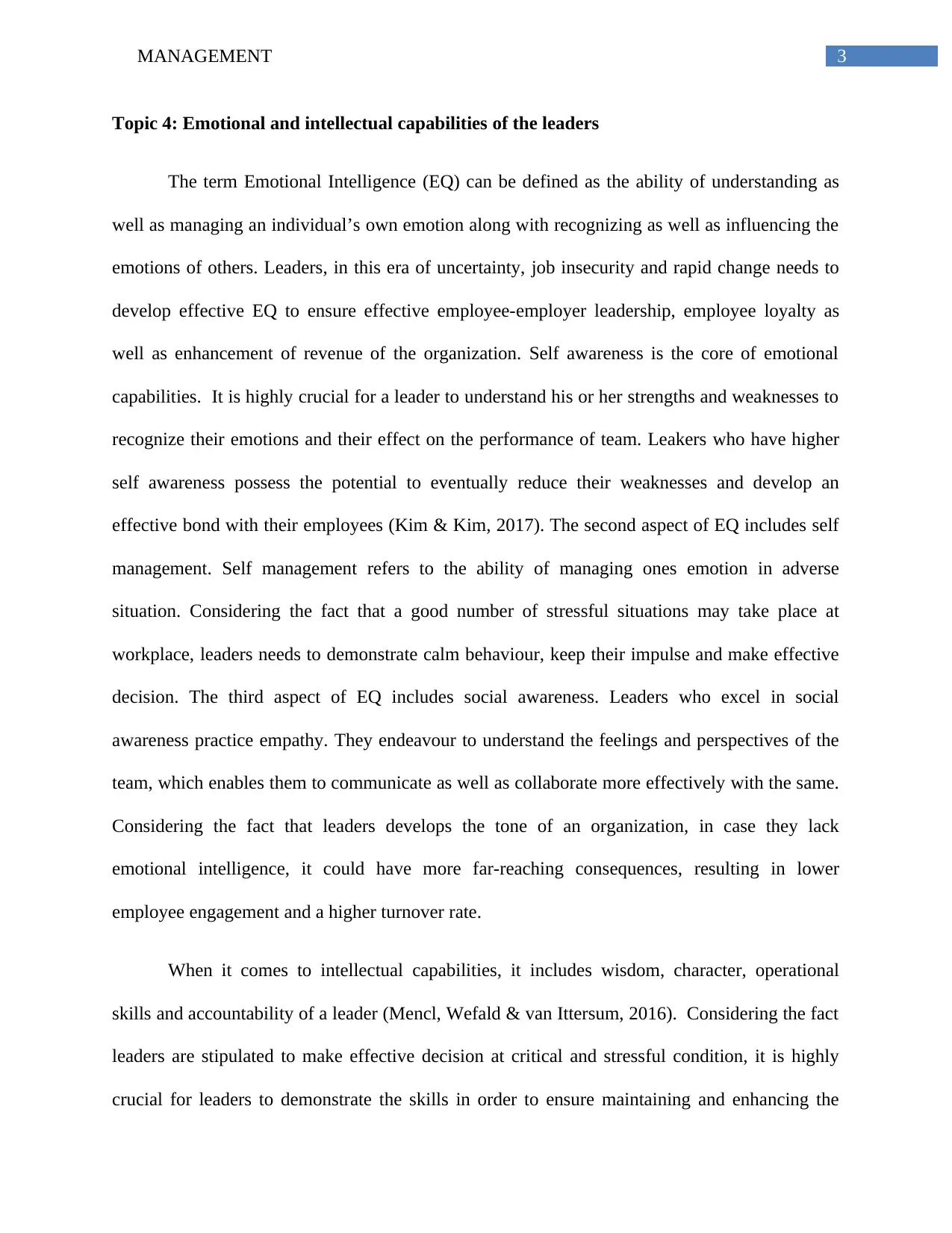
3MANAGEMENT
Topic 4: Emotional and intellectual capabilities of the leaders
The term Emotional Intelligence (EQ) can be defined as the ability of understanding as
well as managing an individual’s own emotion along with recognizing as well as influencing the
emotions of others. Leaders, in this era of uncertainty, job insecurity and rapid change needs to
develop effective EQ to ensure effective employee-employer leadership, employee loyalty as
well as enhancement of revenue of the organization. Self awareness is the core of emotional
capabilities. It is highly crucial for a leader to understand his or her strengths and weaknesses to
recognize their emotions and their effect on the performance of team. Leakers who have higher
self awareness possess the potential to eventually reduce their weaknesses and develop an
effective bond with their employees (Kim & Kim, 2017). The second aspect of EQ includes self
management. Self management refers to the ability of managing ones emotion in adverse
situation. Considering the fact that a good number of stressful situations may take place at
workplace, leaders needs to demonstrate calm behaviour, keep their impulse and make effective
decision. The third aspect of EQ includes social awareness. Leaders who excel in social
awareness practice empathy. They endeavour to understand the feelings and perspectives of the
team, which enables them to communicate as well as collaborate more effectively with the same.
Considering the fact that leaders develops the tone of an organization, in case they lack
emotional intelligence, it could have more far-reaching consequences, resulting in lower
employee engagement and a higher turnover rate.
When it comes to intellectual capabilities, it includes wisdom, character, operational
skills and accountability of a leader (Mencl, Wefald & van Ittersum, 2016). Considering the fact
leaders are stipulated to make effective decision at critical and stressful condition, it is highly
crucial for leaders to demonstrate the skills in order to ensure maintaining and enhancing the
Topic 4: Emotional and intellectual capabilities of the leaders
The term Emotional Intelligence (EQ) can be defined as the ability of understanding as
well as managing an individual’s own emotion along with recognizing as well as influencing the
emotions of others. Leaders, in this era of uncertainty, job insecurity and rapid change needs to
develop effective EQ to ensure effective employee-employer leadership, employee loyalty as
well as enhancement of revenue of the organization. Self awareness is the core of emotional
capabilities. It is highly crucial for a leader to understand his or her strengths and weaknesses to
recognize their emotions and their effect on the performance of team. Leakers who have higher
self awareness possess the potential to eventually reduce their weaknesses and develop an
effective bond with their employees (Kim & Kim, 2017). The second aspect of EQ includes self
management. Self management refers to the ability of managing ones emotion in adverse
situation. Considering the fact that a good number of stressful situations may take place at
workplace, leaders needs to demonstrate calm behaviour, keep their impulse and make effective
decision. The third aspect of EQ includes social awareness. Leaders who excel in social
awareness practice empathy. They endeavour to understand the feelings and perspectives of the
team, which enables them to communicate as well as collaborate more effectively with the same.
Considering the fact that leaders develops the tone of an organization, in case they lack
emotional intelligence, it could have more far-reaching consequences, resulting in lower
employee engagement and a higher turnover rate.
When it comes to intellectual capabilities, it includes wisdom, character, operational
skills and accountability of a leader (Mencl, Wefald & van Ittersum, 2016). Considering the fact
leaders are stipulated to make effective decision at critical and stressful condition, it is highly
crucial for leaders to demonstrate the skills in order to ensure maintaining and enhancing the
Paraphrase This Document
Need a fresh take? Get an instant paraphrase of this document with our AI Paraphraser
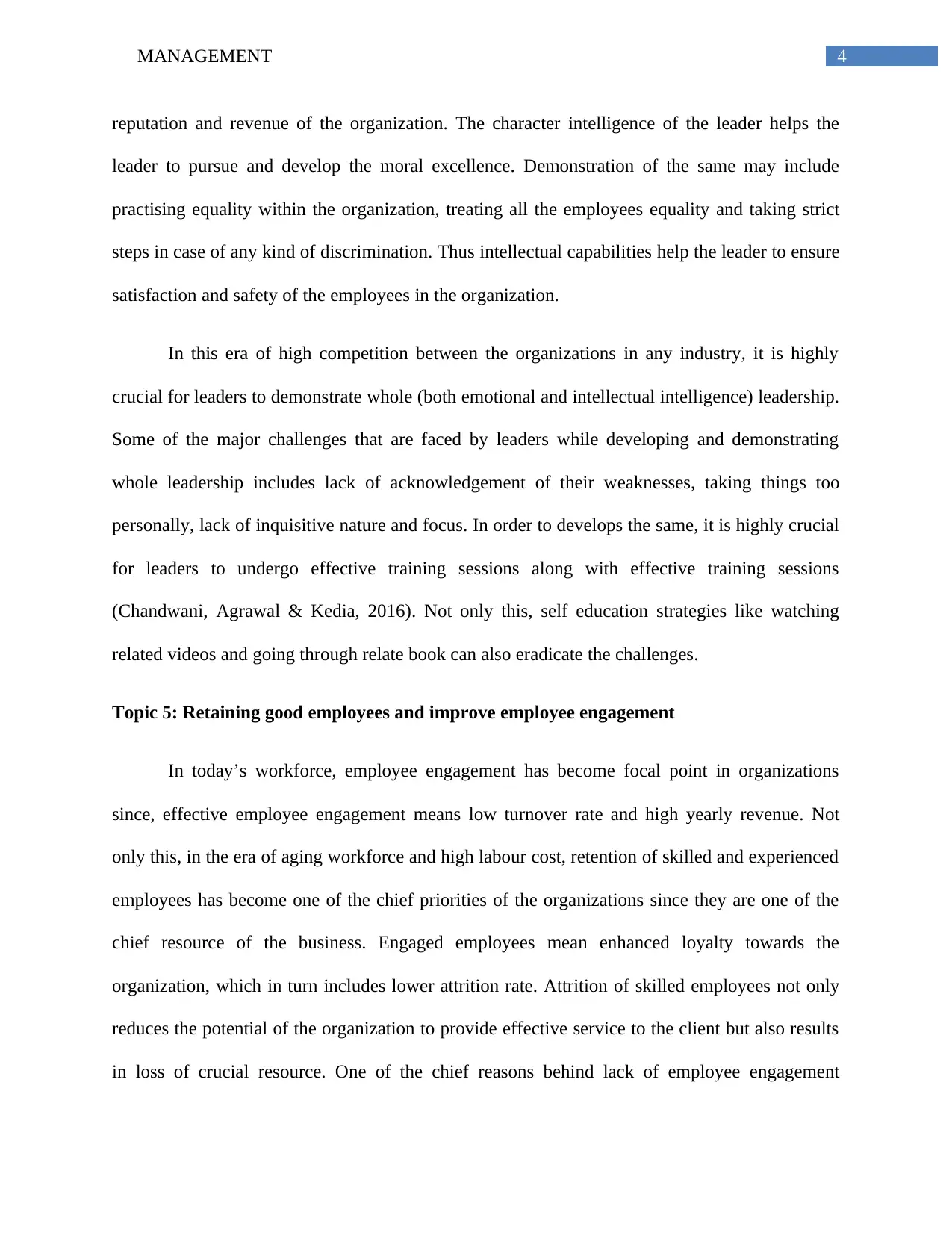
4MANAGEMENT
reputation and revenue of the organization. The character intelligence of the leader helps the
leader to pursue and develop the moral excellence. Demonstration of the same may include
practising equality within the organization, treating all the employees equality and taking strict
steps in case of any kind of discrimination. Thus intellectual capabilities help the leader to ensure
satisfaction and safety of the employees in the organization.
In this era of high competition between the organizations in any industry, it is highly
crucial for leaders to demonstrate whole (both emotional and intellectual intelligence) leadership.
Some of the major challenges that are faced by leaders while developing and demonstrating
whole leadership includes lack of acknowledgement of their weaknesses, taking things too
personally, lack of inquisitive nature and focus. In order to develops the same, it is highly crucial
for leaders to undergo effective training sessions along with effective training sessions
(Chandwani, Agrawal & Kedia, 2016). Not only this, self education strategies like watching
related videos and going through relate book can also eradicate the challenges.
Topic 5: Retaining good employees and improve employee engagement
In today’s workforce, employee engagement has become focal point in organizations
since, effective employee engagement means low turnover rate and high yearly revenue. Not
only this, in the era of aging workforce and high labour cost, retention of skilled and experienced
employees has become one of the chief priorities of the organizations since they are one of the
chief resource of the business. Engaged employees mean enhanced loyalty towards the
organization, which in turn includes lower attrition rate. Attrition of skilled employees not only
reduces the potential of the organization to provide effective service to the client but also results
in loss of crucial resource. One of the chief reasons behind lack of employee engagement
reputation and revenue of the organization. The character intelligence of the leader helps the
leader to pursue and develop the moral excellence. Demonstration of the same may include
practising equality within the organization, treating all the employees equality and taking strict
steps in case of any kind of discrimination. Thus intellectual capabilities help the leader to ensure
satisfaction and safety of the employees in the organization.
In this era of high competition between the organizations in any industry, it is highly
crucial for leaders to demonstrate whole (both emotional and intellectual intelligence) leadership.
Some of the major challenges that are faced by leaders while developing and demonstrating
whole leadership includes lack of acknowledgement of their weaknesses, taking things too
personally, lack of inquisitive nature and focus. In order to develops the same, it is highly crucial
for leaders to undergo effective training sessions along with effective training sessions
(Chandwani, Agrawal & Kedia, 2016). Not only this, self education strategies like watching
related videos and going through relate book can also eradicate the challenges.
Topic 5: Retaining good employees and improve employee engagement
In today’s workforce, employee engagement has become focal point in organizations
since, effective employee engagement means low turnover rate and high yearly revenue. Not
only this, in the era of aging workforce and high labour cost, retention of skilled and experienced
employees has become one of the chief priorities of the organizations since they are one of the
chief resource of the business. Engaged employees mean enhanced loyalty towards the
organization, which in turn includes lower attrition rate. Attrition of skilled employees not only
reduces the potential of the organization to provide effective service to the client but also results
in loss of crucial resource. One of the chief reasons behind lack of employee engagement
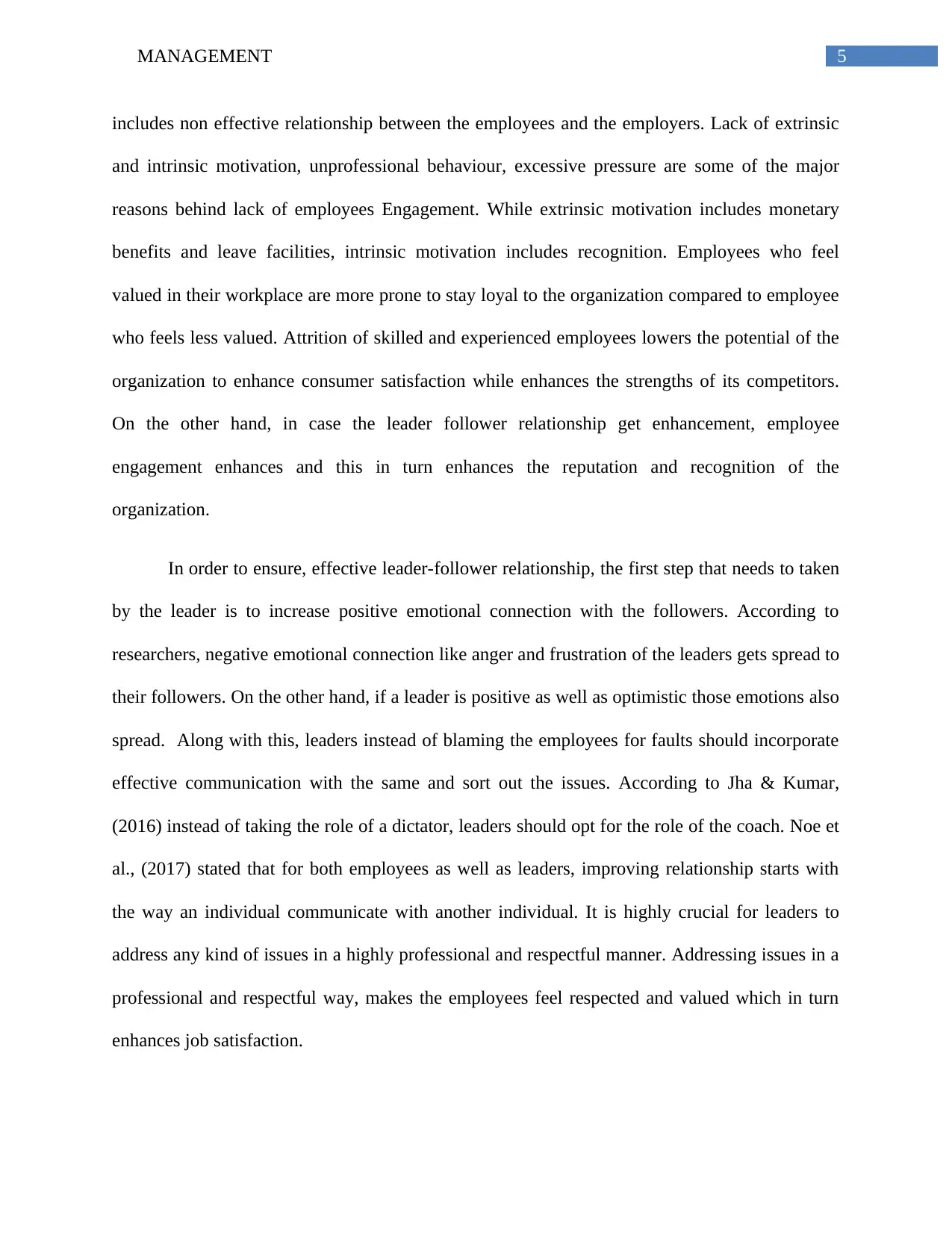
5MANAGEMENT
includes non effective relationship between the employees and the employers. Lack of extrinsic
and intrinsic motivation, unprofessional behaviour, excessive pressure are some of the major
reasons behind lack of employees Engagement. While extrinsic motivation includes monetary
benefits and leave facilities, intrinsic motivation includes recognition. Employees who feel
valued in their workplace are more prone to stay loyal to the organization compared to employee
who feels less valued. Attrition of skilled and experienced employees lowers the potential of the
organization to enhance consumer satisfaction while enhances the strengths of its competitors.
On the other hand, in case the leader follower relationship get enhancement, employee
engagement enhances and this in turn enhances the reputation and recognition of the
organization.
In order to ensure, effective leader-follower relationship, the first step that needs to taken
by the leader is to increase positive emotional connection with the followers. According to
researchers, negative emotional connection like anger and frustration of the leaders gets spread to
their followers. On the other hand, if a leader is positive as well as optimistic those emotions also
spread. Along with this, leaders instead of blaming the employees for faults should incorporate
effective communication with the same and sort out the issues. According to Jha & Kumar,
(2016) instead of taking the role of a dictator, leaders should opt for the role of the coach. Noe et
al., (2017) stated that for both employees as well as leaders, improving relationship starts with
the way an individual communicate with another individual. It is highly crucial for leaders to
address any kind of issues in a highly professional and respectful manner. Addressing issues in a
professional and respectful way, makes the employees feel respected and valued which in turn
enhances job satisfaction.
includes non effective relationship between the employees and the employers. Lack of extrinsic
and intrinsic motivation, unprofessional behaviour, excessive pressure are some of the major
reasons behind lack of employees Engagement. While extrinsic motivation includes monetary
benefits and leave facilities, intrinsic motivation includes recognition. Employees who feel
valued in their workplace are more prone to stay loyal to the organization compared to employee
who feels less valued. Attrition of skilled and experienced employees lowers the potential of the
organization to enhance consumer satisfaction while enhances the strengths of its competitors.
On the other hand, in case the leader follower relationship get enhancement, employee
engagement enhances and this in turn enhances the reputation and recognition of the
organization.
In order to ensure, effective leader-follower relationship, the first step that needs to taken
by the leader is to increase positive emotional connection with the followers. According to
researchers, negative emotional connection like anger and frustration of the leaders gets spread to
their followers. On the other hand, if a leader is positive as well as optimistic those emotions also
spread. Along with this, leaders instead of blaming the employees for faults should incorporate
effective communication with the same and sort out the issues. According to Jha & Kumar,
(2016) instead of taking the role of a dictator, leaders should opt for the role of the coach. Noe et
al., (2017) stated that for both employees as well as leaders, improving relationship starts with
the way an individual communicate with another individual. It is highly crucial for leaders to
address any kind of issues in a highly professional and respectful manner. Addressing issues in a
professional and respectful way, makes the employees feel respected and valued which in turn
enhances job satisfaction.
⊘ This is a preview!⊘
Do you want full access?
Subscribe today to unlock all pages.

Trusted by 1+ million students worldwide
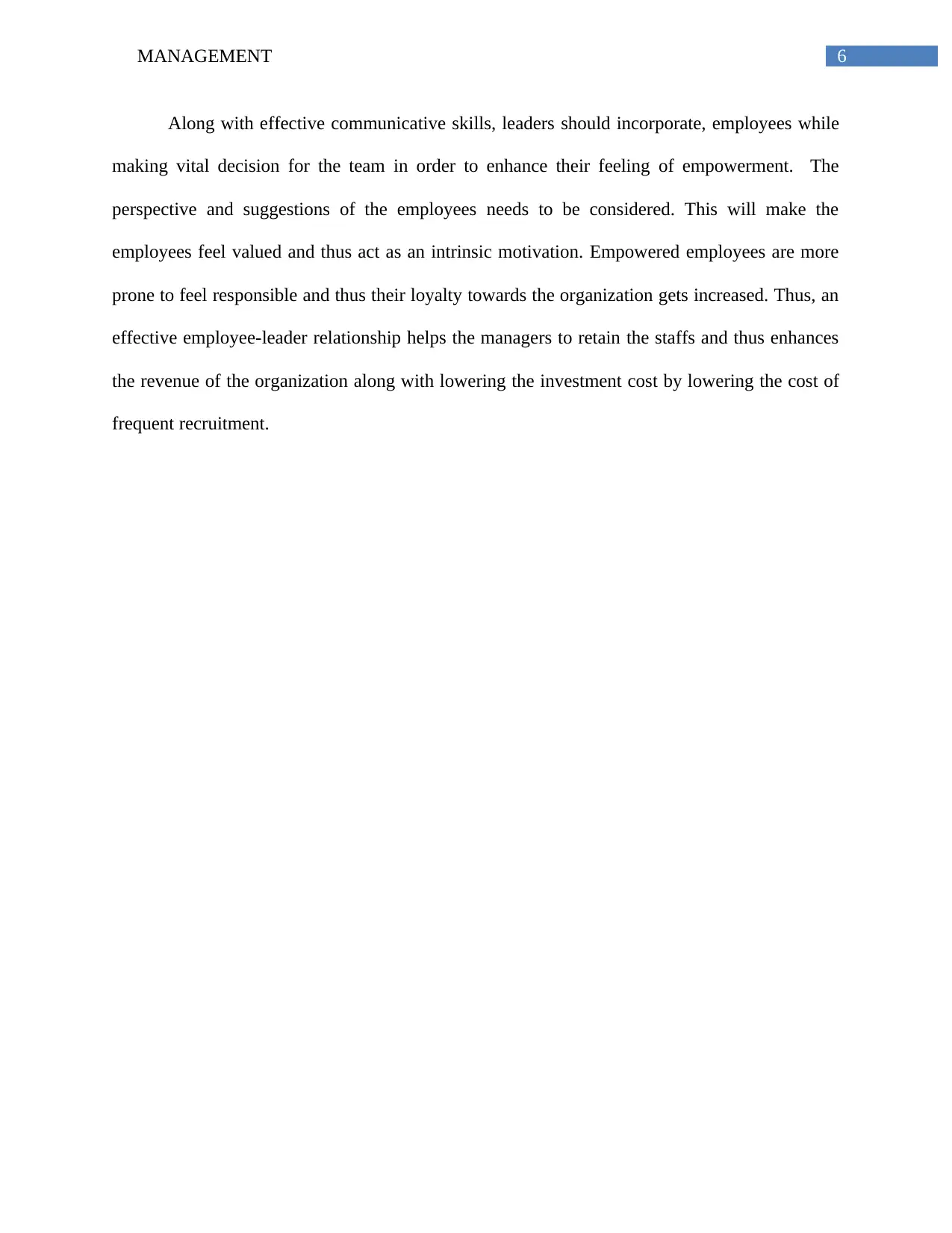
6MANAGEMENT
Along with effective communicative skills, leaders should incorporate, employees while
making vital decision for the team in order to enhance their feeling of empowerment. The
perspective and suggestions of the employees needs to be considered. This will make the
employees feel valued and thus act as an intrinsic motivation. Empowered employees are more
prone to feel responsible and thus their loyalty towards the organization gets increased. Thus, an
effective employee-leader relationship helps the managers to retain the staffs and thus enhances
the revenue of the organization along with lowering the investment cost by lowering the cost of
frequent recruitment.
Along with effective communicative skills, leaders should incorporate, employees while
making vital decision for the team in order to enhance their feeling of empowerment. The
perspective and suggestions of the employees needs to be considered. This will make the
employees feel valued and thus act as an intrinsic motivation. Empowered employees are more
prone to feel responsible and thus their loyalty towards the organization gets increased. Thus, an
effective employee-leader relationship helps the managers to retain the staffs and thus enhances
the revenue of the organization along with lowering the investment cost by lowering the cost of
frequent recruitment.
Paraphrase This Document
Need a fresh take? Get an instant paraphrase of this document with our AI Paraphraser
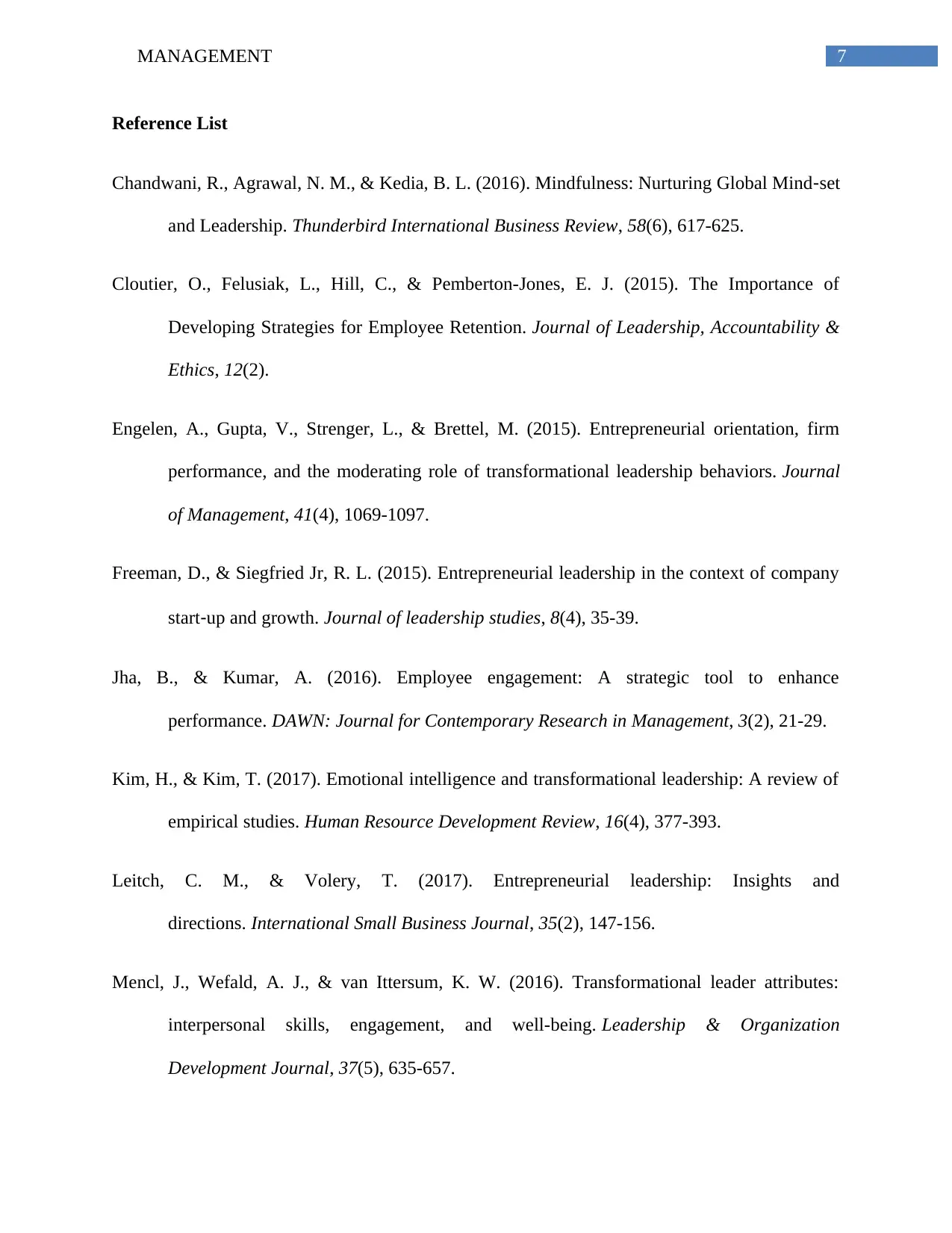
7MANAGEMENT
Reference List
Chandwani, R., Agrawal, N. M., & Kedia, B. L. (2016). Mindfulness: Nurturing Global Mind‐set
and Leadership. Thunderbird International Business Review, 58(6), 617-625.
Cloutier, O., Felusiak, L., Hill, C., & Pemberton-Jones, E. J. (2015). The Importance of
Developing Strategies for Employee Retention. Journal of Leadership, Accountability &
Ethics, 12(2).
Engelen, A., Gupta, V., Strenger, L., & Brettel, M. (2015). Entrepreneurial orientation, firm
performance, and the moderating role of transformational leadership behaviors. Journal
of Management, 41(4), 1069-1097.
Freeman, D., & Siegfried Jr, R. L. (2015). Entrepreneurial leadership in the context of company
start‐up and growth. Journal of leadership studies, 8(4), 35-39.
Jha, B., & Kumar, A. (2016). Employee engagement: A strategic tool to enhance
performance. DAWN: Journal for Contemporary Research in Management, 3(2), 21-29.
Kim, H., & Kim, T. (2017). Emotional intelligence and transformational leadership: A review of
empirical studies. Human Resource Development Review, 16(4), 377-393.
Leitch, C. M., & Volery, T. (2017). Entrepreneurial leadership: Insights and
directions. International Small Business Journal, 35(2), 147-156.
Mencl, J., Wefald, A. J., & van Ittersum, K. W. (2016). Transformational leader attributes:
interpersonal skills, engagement, and well-being. Leadership & Organization
Development Journal, 37(5), 635-657.
Reference List
Chandwani, R., Agrawal, N. M., & Kedia, B. L. (2016). Mindfulness: Nurturing Global Mind‐set
and Leadership. Thunderbird International Business Review, 58(6), 617-625.
Cloutier, O., Felusiak, L., Hill, C., & Pemberton-Jones, E. J. (2015). The Importance of
Developing Strategies for Employee Retention. Journal of Leadership, Accountability &
Ethics, 12(2).
Engelen, A., Gupta, V., Strenger, L., & Brettel, M. (2015). Entrepreneurial orientation, firm
performance, and the moderating role of transformational leadership behaviors. Journal
of Management, 41(4), 1069-1097.
Freeman, D., & Siegfried Jr, R. L. (2015). Entrepreneurial leadership in the context of company
start‐up and growth. Journal of leadership studies, 8(4), 35-39.
Jha, B., & Kumar, A. (2016). Employee engagement: A strategic tool to enhance
performance. DAWN: Journal for Contemporary Research in Management, 3(2), 21-29.
Kim, H., & Kim, T. (2017). Emotional intelligence and transformational leadership: A review of
empirical studies. Human Resource Development Review, 16(4), 377-393.
Leitch, C. M., & Volery, T. (2017). Entrepreneurial leadership: Insights and
directions. International Small Business Journal, 35(2), 147-156.
Mencl, J., Wefald, A. J., & van Ittersum, K. W. (2016). Transformational leader attributes:
interpersonal skills, engagement, and well-being. Leadership & Organization
Development Journal, 37(5), 635-657.

8MANAGEMENT
Noe, R. A., Hollenbeck, J. R., Gerhart, B., & Wright, P. M. (2017). Human resource
management: Gaining a competitive advantage. New York, NY: McGraw-Hill
Education.
Noe, R. A., Hollenbeck, J. R., Gerhart, B., & Wright, P. M. (2017). Human resource
management: Gaining a competitive advantage. New York, NY: McGraw-Hill
Education.
⊘ This is a preview!⊘
Do you want full access?
Subscribe today to unlock all pages.

Trusted by 1+ million students worldwide
1 out of 9
Related Documents
Your All-in-One AI-Powered Toolkit for Academic Success.
+13062052269
info@desklib.com
Available 24*7 on WhatsApp / Email
![[object Object]](/_next/static/media/star-bottom.7253800d.svg)
Unlock your academic potential
Copyright © 2020–2025 A2Z Services. All Rights Reserved. Developed and managed by ZUCOL.





